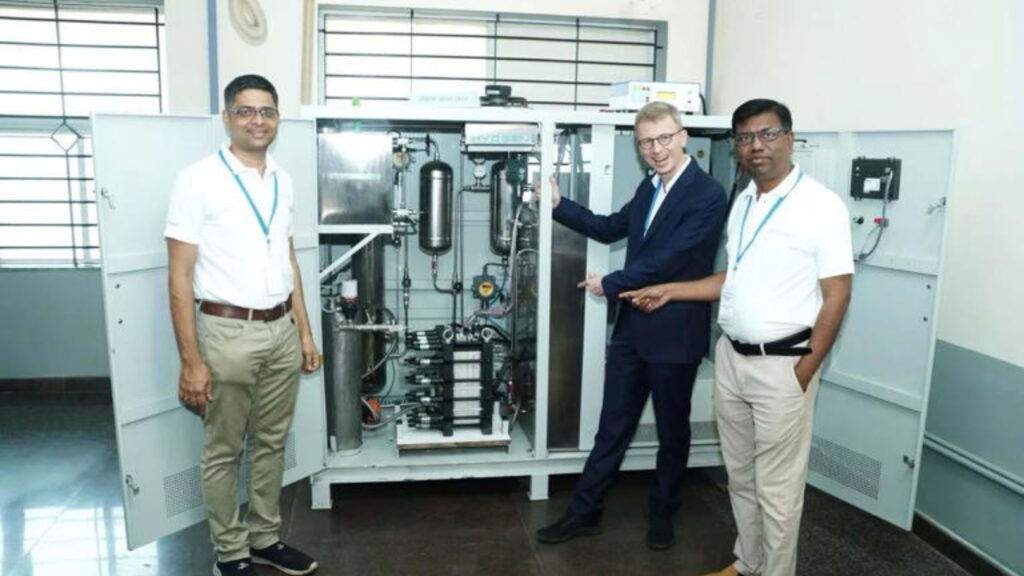Fresh capital will fuel HYDGEN’s expansion from Mangalore to global markets, as it scales cost-efficient hydrogen for the industrial world.
HYDGEN, a Singapore- and India-based deeptech startup pioneering cost-efficient green hydrogen generation, has raised US$5 million in a Pre-Series A round, combining equity and debt financing. The round was led by Transition Venture Capital (India), with participation from Cloudberry Pioneer Investments (Europe), Moringa Ventures (Singapore), and several strategic family offices from India and Singapore.
The funding marks a major step forward for HYDGEN’s mission to make ultra-pure, industrial-grade hydrogen available on-site and on-demand — a challenge that sits at the intersection of clean energy transition and industrial efficiency.
Fixing the Broken Hydrogen Supply Chain
Despite being a US$150 billion global market, hydrogen today suffers from an outdated supply chain. Most industrial users — from semiconductor fabs and refineries to diamond manufacturers and research labs — depend on hydrogen delivered in pressurized cylinders or tanker trucks. This model is not only expensive but inefficient, often adding US$2–3 per kilogram in logistics costs and still failing to meet purity standards demanded by advanced industries.
As a result, many of these sectors face a dilemma: they need hydrogen every day, but the current delivery model is slow, carbon-intensive, and unreliable. On-site generation — producing hydrogen directly where it’s consumed — is emerging as a viable alternative that improves supply resilience, lowers costs, and helps industries scale sustainably.
“Many discussions about hydrogen focus on its role in a clean energy future, but the urgent opportunity is enabling industries to have hydrogen where and when they need it, with purity they can trust,” said Dr. Manipaddy Krishna Kumar, Co-founder and COO of HYDGEN. “Our AEM electrolyzers allow companies to produce hydrogen on-site at a competitive cost, solving supply chain challenges today while preparing them for the broader transition to green hydrogen in the years ahead.”
AEM Innovation: The Technology Behind HYDGEN
HYDGEN’s proprietary Anion Exchange Membrane (AEM) electrolyzer technology sits at the heart of its innovation. The company claims to combine the affordability of alkaline electrolysis with the efficiency and responsiveness of Proton Exchange Membrane (PEM) systems, while eliminating the need for costly platinum-group metals typically used in PEM systems.
Key advantages of HYDGEN’s AEM systems include:
- Lowest unit cost in the industry, driven by proprietary catalysts, membranes, and stack design
- Ultra-pure hydrogen output, without requiring additional purification systems
- On-site, on-demand generation, cutting transport and storage costs
- Industrial-grade stack range from 1 kW to 100 kW, with 250 kW single stacks under development
“HYDGEN is the first team we’ve seen that can scale AEM electrolyzers to true industrial levels while maintaining cost leadership,” said Mohamed Shoeb Ali, Managing Partner at Transition VC. “This is not a research project anymore; it’s a commercially ready platform for industries already spending billions on hydrogen.”
From Research to Real-World Deployment
Over the past year, HYDGEN has moved quickly from lab innovation to field deployment. The company has launched pilot projects across India, Singapore, and Southeast Asia, validating both its technology readiness and commercial viability. Several partners have now scaled their pilots into full industrial deployments.

“What impressed us was HYDGEN’s ability to combine high-purity output with a low-CAPEX modular design,” said Mahir Sahin, Founding Partner at Cloudberry Pioneer Investments. “That combination is exactly what industrial users need to decarbonize today.”
These early deployments demonstrate that HYDGEN’s model works not just as a future vision but as a practical, near-term decarbonization tool — directly replacing trucked hydrogen with localized, on-demand production.
Scaling from Mangalore to Global Markets
With its newly secured funding, HYDGEN plans to upgrade its manufacturing facility in Mangalore, India to a semi-automated assembly line — establishing a cost-efficient production hub for Asia and beyond.
The capital will also be used to:
- Increase single AEM stack capacity to 250 kW, strengthening industrial scalability
- Expand into new global markets, including Japan, Europe, and the Middle East
- Accelerate commercialization efforts for on-site hydrogen generation
This expansion aligns with the growing industrial hydrogen demand across Asia, where countries are pushing aggressive decarbonization targets backed by government incentives and private sector partnerships.
Riding the Policy Wave
The rise of green hydrogen is being powered by global policy momentum. India’s National Green Hydrogen Mission, the EU’s hydrogen subsidies, and Canada’s Clean Hydrogen Investment Tax Credit all support adoption. But for HYDGEN, the business case is strong even without subsidies.
“Hydrogen is central to the world’s industrial and energy transition, yet much of today’s supply remains carbon-intensive and costly to transport,” said Theodora Lai, Partner and Co-founder of Moringa Ventures. “We believe decentralized hydrogen production will reshape the US$260 billion global hydrogen market. HYDGEN’s scalable AEM technology puts them ahead of that curve — solving industrial challenges while accelerating the clean transition.”
The Road Ahead
Incubated as a spin-out from the National University of Singapore (NUS), HYDGEN has evolved into a deeptech company with strong engineering and manufacturing capabilities in India. Its stack designs, ranging from 1 kW to 100 kW and scaling to 250 kW, are targeted at industrial users seeking reliability, efficiency, and purity — key bottlenecks in today’s hydrogen supply.
“Our mission is simple: make green hydrogen cheaper, purer, and always available where industries need it most,” said Dr. Goutam Dalapati, Co-founder and CTO of HYDGEN.
As industries across Asia seek to decarbonize without compromising cost or uptime, HYDGEN’s on-site generation model offers a compelling bridge between immediate operational needs and long-term sustainability goals.
Conclusion
HYDGEN’s US$5 million Pre-Series A round signals a new phase for green hydrogen commercialization in Asia — moving from pilot projects to scalable industrial deployment. By tackling the fundamental inefficiencies of hydrogen logistics with a decentralized, cost-efficient production model, HYDGEN is positioning itself at the forefront of the industrial clean energy transition.
Its blend of deeptech innovation, manufacturing readiness, and market traction places it among the rare few climate-tech startups ready to make green hydrogen not just viable — but vital — for industries worldwide.




